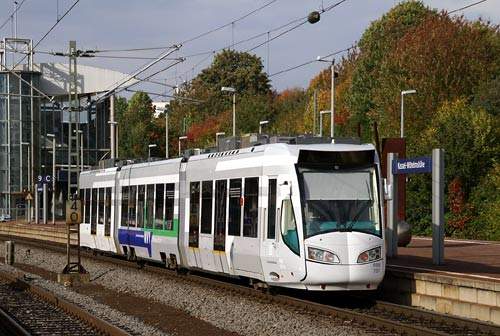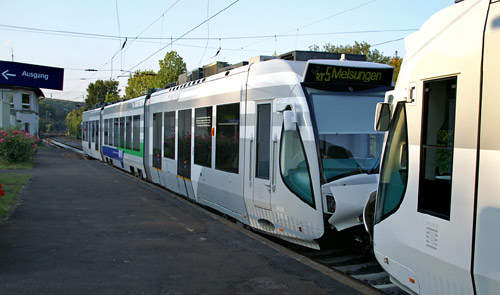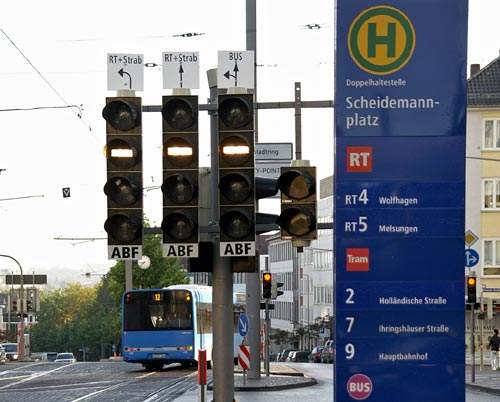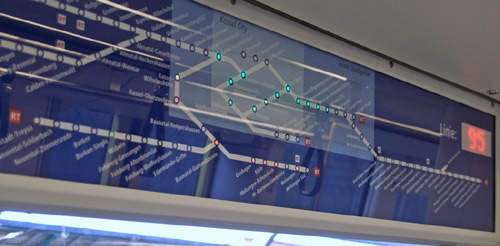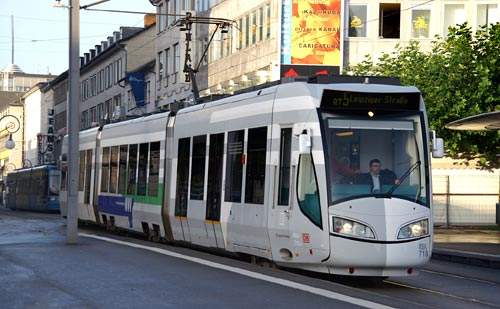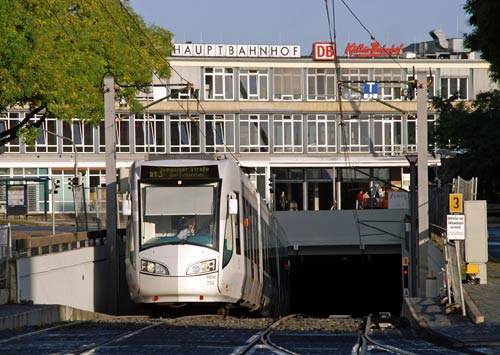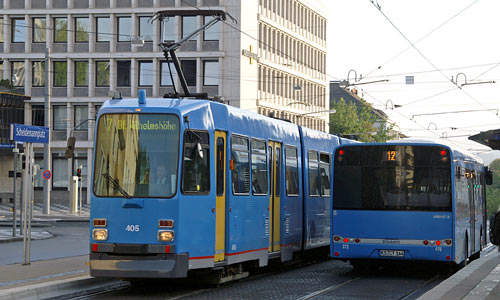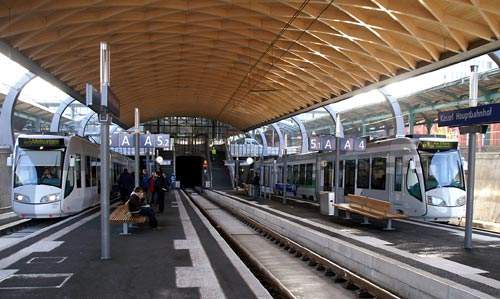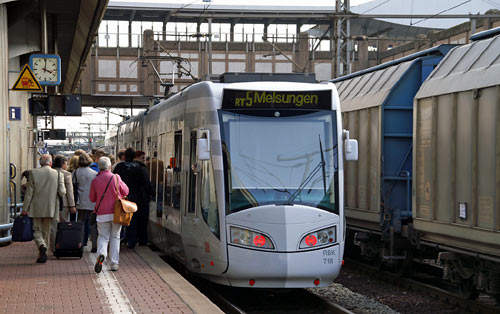Germany is a leader in tram train operations, whereby infrastructure and rolling stock allow for through running between heavy rail and urban light rail systems. Often referred to as the ‘Karlsruhe Model’ after the dual-mode network centred on the city in Baden-Württemberg, Kassel in Hessen state has added an extra dimension with the incorporation of diesel-powered vehicles. Full tram-train working began in September 2007 with the opening of the tramway/heavy rail link.
Kassel is the major city of north Hessen, set amidst hilly countryside by the Fulda river valley. It has a strong railway identity, being the location of Bombardier’s locomotive plant and on DB’s freight, regional, Intercity and ICE routes.
Unusual in that the designated Hauptbahnhof (Hbf) near the city centre is secondary in importance to the Kassel-Wilhelmshöhe station opened in 1991 for Germany’s first ICE Neubaustrecke, Kassel also features a tramway system dating from 1877 and electrified in 1897.
THE PROJECT
To enable better transit between Kassel and its satellite communities, decisions were made in the early 1990s to extend urban services onto lines that had become freight only. The project took on a new dimension following the 1999 study Schiene 21 that was to lead to the connection of DB passenger lines to the Kasseler Verkehrs-Gesellschaft (KVG) tram network.
Prior to the delivery of the RegioTrams ordered in 2001, trials took place on the Kassel-Warburg line using Bombardier-built vehicles leased from Saarbrücken, another German tram-train operator. In providing frequent services with new stock that allows for more transfer-free journeys, the project is regarded as a key element in the obligation of regional transport authority Nordhessische VerkehrsVerbund (NVV) to the half-million people in its area.
The project cost €180m, with an approximate infrastructure/rolling stock proportion of 95/85 shared amongst several partners. Federal and state governments represent the main funding sources (90% of total), with contributions also from local authorities benefiting from the service.
The new mode is designated and marketed as RegioTram, with routes identified RT2 (to Hessich Lichtenau); RT3 (Warburg, Nordrhein-Westfalen); RT4 (Wolfhagen) and RT5 (Melsungen-Süd).
INFRASTRUCTURE
To create what has become a 122km RegioTram network, it was necessary to add new track totalling 10km. Signalling has been modified to account for higher frequencies. The line west from the Hbf carrying RT3 and RT4 and DB regional services, the Harleshäuser curve, has had stations added to serve the western suburbs of Kassel.
A key project element was creating a physical link between tram and DB tracks. By re-using part of the tram tunnel that originally ran beneath the Hbf frontage as part of a tram loop, three low-level Hbf platforms for RegioTrams have been created on the south side of the DB terminus tracks.
To restore the tram service at the north-west of the city centre lost to the project, new track was added from Scheidemann-Platz (where RegioTrams join the tram system) to Luther-Platz. RegioTram services have restored importance to the Hauptbahnhof, with RT5 increasing the frequency of links between there and Kassel-Wilhelmshöhe.
ROLLING STOCK
The service is entirely worked by three-car, 75% low floor Alstom Regio Citadis vehicles constructed at Salzgitter, Niedersachsen. Delivered 2004–2005, the air-conditioned fleet consists of two types which are visually near identical. Numbers 701–718 are two-system overhead supply electrics for operation on DB routes (15kV ac) and the Kassel tram system (750V dc). Unlike the trams alongside which they operate, the RegioTrams are bi-directional.
To enable operation to Wolfhagen without disproportionately expensive route re-engineering for electrification, different stock was required. Numbers 751–760 represent a world first in tram fleet operation, fitted with roof-mounted diesel engines to maintain the low floor profile, a hybrid (electro-diesel) for use without an external power supply or through the 750V overhead. The hybrids also are also used as required for routes that are fully wired.
Services are formed of single or double sets. Relative to the two-system electrics, hybrid sets have a reduced standing capacity (127 as opposed to 139) caused by body-side space needed for fuel storage. Both types feature luggage racks and two general-purpose areas to facilitate access for the mobility-impaired and carriage of cycles and prams. The centre car features seating more appropriate to longer journeys. Each set has interior decoration and names drawn from the stories of the Brothers Grimm who settled in Kassel.
SIGNALLING AND COMMUNICATION
By definition tram-trains must work under the control systems of whichever network they work over. As road stops are also used by buses, tram-type signalling has up to three different displays for the different modes. RegioTrams have an internal illuminated display that represents progress thought the stops on that particular service, plus audio announcements.
RegioTram services are covered under the ticketing arrangements of DB (including the Hessen Ticket), the municipal authorities and NVV. Vehicles include ticket vending machines.
THE FUTURE
When the Kassel Hbf connection opened, minor works were still required around the station area. The project stages remaining to 2009 relate to stations on the Harleshäuser curve, signalling modifications and establishment of a basic 30-minute frequency on RT routes.
Rather than replicate services of DB regional trains over the same routes, the latter now call at fewer stations, enabling faster end-to-end times, with the RegioTrams now serving the intermediate stations.
As with Karlsruhe, Kassel’s tram-train operation has attracted interest from other operators wishing to assess the effectiveness of running vehicles seamlessly between street and railway.

